12.22: Vertebrate Diversity
- Page ID
- 1410
\( \newcommand{\vecs}[1]{\overset { \scriptstyle \rightharpoonup} {\mathbf{#1}} } \)
\( \newcommand{\vecd}[1]{\overset{-\!-\!\rightharpoonup}{\vphantom{a}\smash {#1}}} \)
\( \newcommand{\dsum}{\displaystyle\sum\limits} \)
\( \newcommand{\dint}{\displaystyle\int\limits} \)
\( \newcommand{\dlim}{\displaystyle\lim\limits} \)
\( \newcommand{\id}{\mathrm{id}}\) \( \newcommand{\Span}{\mathrm{span}}\)
( \newcommand{\kernel}{\mathrm{null}\,}\) \( \newcommand{\range}{\mathrm{range}\,}\)
\( \newcommand{\RealPart}{\mathrm{Re}}\) \( \newcommand{\ImaginaryPart}{\mathrm{Im}}\)
\( \newcommand{\Argument}{\mathrm{Arg}}\) \( \newcommand{\norm}[1]{\| #1 \|}\)
\( \newcommand{\inner}[2]{\langle #1, #2 \rangle}\)
\( \newcommand{\Span}{\mathrm{span}}\)
\( \newcommand{\id}{\mathrm{id}}\)
\( \newcommand{\Span}{\mathrm{span}}\)
\( \newcommand{\kernel}{\mathrm{null}\,}\)
\( \newcommand{\range}{\mathrm{range}\,}\)
\( \newcommand{\RealPart}{\mathrm{Re}}\)
\( \newcommand{\ImaginaryPart}{\mathrm{Im}}\)
\( \newcommand{\Argument}{\mathrm{Arg}}\)
\( \newcommand{\norm}[1]{\| #1 \|}\)
\( \newcommand{\inner}[2]{\langle #1, #2 \rangle}\)
\( \newcommand{\Span}{\mathrm{span}}\) \( \newcommand{\AA}{\unicode[.8,0]{x212B}}\)
\( \newcommand{\vectorA}[1]{\vec{#1}} % arrow\)
\( \newcommand{\vectorAt}[1]{\vec{\text{#1}}} % arrow\)
\( \newcommand{\vectorB}[1]{\overset { \scriptstyle \rightharpoonup} {\mathbf{#1}} } \)
\( \newcommand{\vectorC}[1]{\textbf{#1}} \)
\( \newcommand{\vectorD}[1]{\overrightarrow{#1}} \)
\( \newcommand{\vectorDt}[1]{\overrightarrow{\text{#1}}} \)
\( \newcommand{\vectE}[1]{\overset{-\!-\!\rightharpoonup}{\vphantom{a}\smash{\mathbf {#1}}}} \)
\( \newcommand{\vecs}[1]{\overset { \scriptstyle \rightharpoonup} {\mathbf{#1}} } \)
\( \newcommand{\vecd}[1]{\overset{-\!-\!\rightharpoonup}{\vphantom{a}\smash {#1}}} \)
\(\newcommand{\avec}{\mathbf a}\) \(\newcommand{\bvec}{\mathbf b}\) \(\newcommand{\cvec}{\mathbf c}\) \(\newcommand{\dvec}{\mathbf d}\) \(\newcommand{\dtil}{\widetilde{\mathbf d}}\) \(\newcommand{\evec}{\mathbf e}\) \(\newcommand{\fvec}{\mathbf f}\) \(\newcommand{\nvec}{\mathbf n}\) \(\newcommand{\pvec}{\mathbf p}\) \(\newcommand{\qvec}{\mathbf q}\) \(\newcommand{\svec}{\mathbf s}\) \(\newcommand{\tvec}{\mathbf t}\) \(\newcommand{\uvec}{\mathbf u}\) \(\newcommand{\vvec}{\mathbf v}\) \(\newcommand{\wvec}{\mathbf w}\) \(\newcommand{\xvec}{\mathbf x}\) \(\newcommand{\yvec}{\mathbf y}\) \(\newcommand{\zvec}{\mathbf z}\) \(\newcommand{\rvec}{\mathbf r}\) \(\newcommand{\mvec}{\mathbf m}\) \(\newcommand{\zerovec}{\mathbf 0}\) \(\newcommand{\onevec}{\mathbf 1}\) \(\newcommand{\real}{\mathbb R}\) \(\newcommand{\twovec}[2]{\left[\begin{array}{r}#1 \\ #2 \end{array}\right]}\) \(\newcommand{\ctwovec}[2]{\left[\begin{array}{c}#1 \\ #2 \end{array}\right]}\) \(\newcommand{\threevec}[3]{\left[\begin{array}{r}#1 \\ #2 \\ #3 \end{array}\right]}\) \(\newcommand{\cthreevec}[3]{\left[\begin{array}{c}#1 \\ #2 \\ #3 \end{array}\right]}\) \(\newcommand{\fourvec}[4]{\left[\begin{array}{r}#1 \\ #2 \\ #3 \\ #4 \end{array}\right]}\) \(\newcommand{\cfourvec}[4]{\left[\begin{array}{c}#1 \\ #2 \\ #3 \\ #4 \end{array}\right]}\) \(\newcommand{\fivevec}[5]{\left[\begin{array}{r}#1 \\ #2 \\ #3 \\ #4 \\ #5 \\ \end{array}\right]}\) \(\newcommand{\cfivevec}[5]{\left[\begin{array}{c}#1 \\ #2 \\ #3 \\ #4 \\ #5 \\ \end{array}\right]}\) \(\newcommand{\mattwo}[4]{\left[\begin{array}{rr}#1 \amp #2 \\ #3 \amp #4 \\ \end{array}\right]}\) \(\newcommand{\laspan}[1]{\text{Span}\{#1\}}\) \(\newcommand{\bcal}{\cal B}\) \(\newcommand{\ccal}{\cal C}\) \(\newcommand{\scal}{\cal S}\) \(\newcommand{\wcal}{\cal W}\) \(\newcommand{\ecal}{\cal E}\) \(\newcommand{\coords}[2]{\left\{#1\right\}_{#2}}\) \(\newcommand{\gray}[1]{\color{gray}{#1}}\) \(\newcommand{\lgray}[1]{\color{lightgray}{#1}}\) \(\newcommand{\rank}{\operatorname{rank}}\) \(\newcommand{\row}{\text{Row}}\) \(\newcommand{\col}{\text{Col}}\) \(\renewcommand{\row}{\text{Row}}\) \(\newcommand{\nul}{\text{Nul}}\) \(\newcommand{\var}{\text{Var}}\) \(\newcommand{\corr}{\text{corr}}\) \(\newcommand{\len}[1]{\left|#1\right|}\) \(\newcommand{\bbar}{\overline{\bvec}}\) \(\newcommand{\bhat}{\widehat{\bvec}}\) \(\newcommand{\bperp}{\bvec^\perp}\) \(\newcommand{\xhat}{\widehat{\xvec}}\) \(\newcommand{\vhat}{\widehat{\vvec}}\) \(\newcommand{\uhat}{\widehat{\uvec}}\) \(\newcommand{\what}{\widehat{\wvec}}\) \(\newcommand{\Sighat}{\widehat{\Sigma}}\) \(\newcommand{\lt}{<}\) \(\newcommand{\gt}{>}\) \(\newcommand{\amp}{&}\) \(\definecolor{fillinmathshade}{gray}{0.9}\)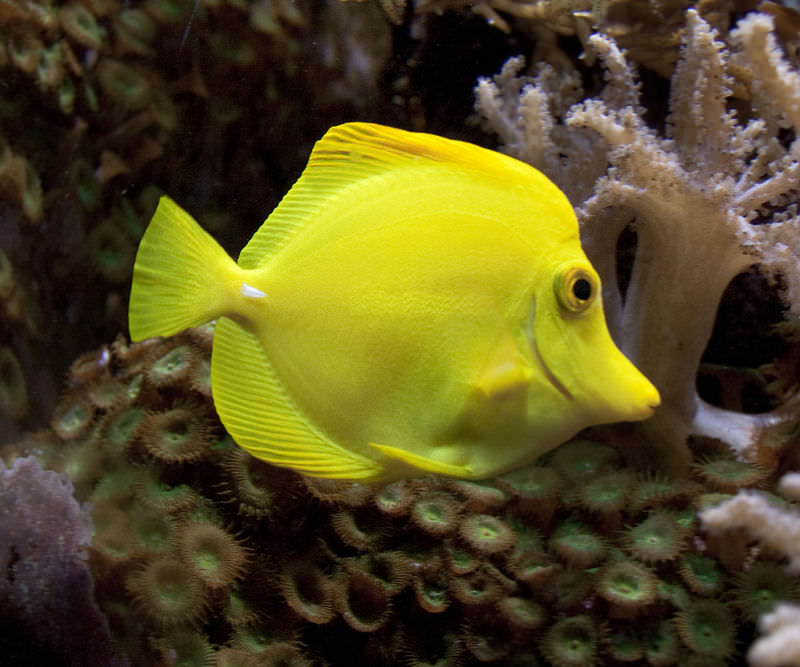
What traits set this animal apart from invertebrate chordates?
This small colorful fish is a vertebrate - it has a backbone. And vertebral columns first evolved in fish. Think about the invertebrate chordates. They live in the ocean, so it only makes sense that fish would be the first true vertebrates. Vertebrates are a subphylum of the phylum Chordata. Like all chordates, vertebrates have a notochord, a dorsal hollow nerve cord, pharyngeal slits, and a post-anal tail. What other characteristics do vertebrates have?
Characteristics of Vertebrates
The main distinguishing feature of vertebrates is their vertebral column, or backbone (see Figure below). The backbone runs from the head to the tail along the dorsal (top) side of the body. The vertebral column is the core of the endoskeleton. It allows a vertebrate to hold its shape. It also houses and protects the spinal (nerve) cord that passes through it. The vertebral column is made up of repeating units called vertebrae (singular, vertebra). In many species, there are shock-absorbing discs between the vertebrae to cushion them during movement.
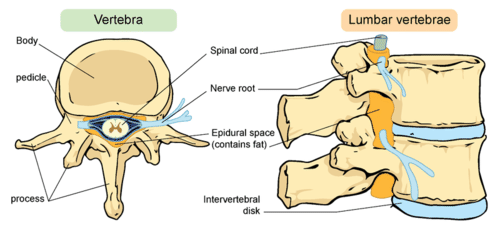 Human Vertebral Column and Vertebrae. The human vertebral column consists of 33 vertebrae. Two vertebrae are shown here enlarged.
Human Vertebral Column and Vertebrae. The human vertebral column consists of 33 vertebrae. Two vertebrae are shown here enlarged.Vertebrate Endoskeleton
Another distinguishing feature of vertebrates is an endoskeleton made of bone or cartilage. Cartilage is a tough tissue that contains a protein called collagen. Bone is a hard tissue that consists of a collagen matrix, or framework, filled in with minerals such as calcium. Bone is less flexible than cartilage but stronger. An endoskeleton made of bone rather than cartilage allows animals to grow larger and heavier. Bone also provides more protection for soft tissues and internal organs.
As shown in Figure below, the vertebrate endoskeleton includes a cranium, or skull, to enclose and protect the brain. It also generally includes two pairs of limbs. Limb girdles (such as the human hips and shoulders) connect the limbs to the rest of the endoskeleton.
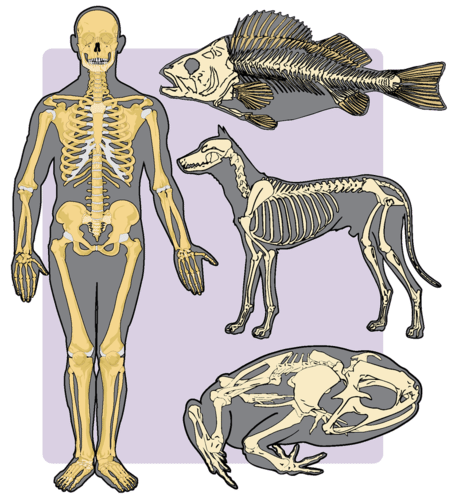 Vertebrate Endoskeletons. The vertebrate endoskeleton includes a vertebral column, cranium, limbs, and limb girdles. Can you find these parts in each endoskeleton shown here?
Vertebrate Endoskeletons. The vertebrate endoskeleton includes a vertebral column, cranium, limbs, and limb girdles. Can you find these parts in each endoskeleton shown here?Other Vertebrate Traits
There are several additional traits found in virtually all vertebrates.
- Vertebrates have a system of muscles attached to the endoskeleton to enable movement. Muscles control movement by alternately contracting (shortening) and relaxing (lengthening). Generally, muscles work together in opposing pairs.
- Vertebrates have a closed circulatory system with a heart. Blood is completely contained within blood vessels that carry the blood throughout the body. The heart is divided into chambers that work together to pump blood. There are between two and four chambers in the vertebrate heart. With more chambers, there is more oxygen in the blood and more vigorous pumping action.
- Most vertebrates have skin covered with scales, feathers, fur, or hair. These features serve a variety of functions, such as waterproofing and insulating the body.
- Vertebrates have an excretory system that includes a pair of kidneys. Kidneys are organs that filter wastes from blood so they can be excreted from the body.
- Vertebrates have an endocrine system of glands that secrete hormones. Hormones are chemical messengers that control many body functions.
- Vertebrates have an adaptive immune system. The immune system is the organ system that defends the body from pathogens and other causes of disease. Being adaptive means that the immune system can "learn" to recognize specific pathogens. Then it can produce tailor-made proteins called antibodies to "attack" them. This allows the immune system to launch a rapid attack whenever the pathogens invade the body again.
- Vertebrates have a centralized nervous system. As shown in Figure below, the nervous system consists of a brain in the head region. It also includes a long spinal cord that runs from the brain to the tail end of the backbone. Long nerve fibers extend from the spinal cord to muscles and organs throughout the body.
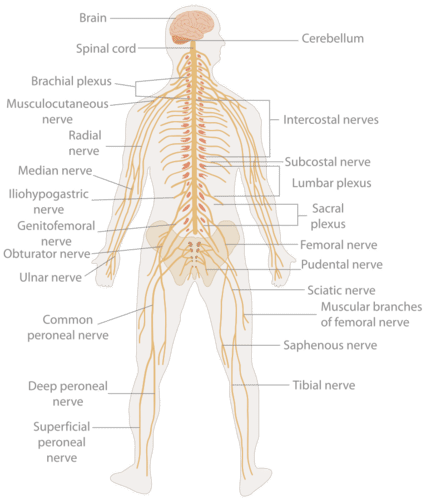 Nervous System (Human). The vertebrate nervous system includes a brain and spinal cord. It also includes a body-wide network of nerves, called peripheral nerves. They connect the spinal cord with the rest of the body.
Nervous System (Human). The vertebrate nervous system includes a brain and spinal cord. It also includes a body-wide network of nerves, called peripheral nerves. They connect the spinal cord with the rest of the body.Summary
- Vertebrates are a subphylum of chordates that have a vertebral column and an endoskeleton made of cartilage or bone.
- Vertebrates also have complex organ systems, including a closed circulatory system with a heart, an excretory system with a pair of kidneys, and an adaptive immune system.
Review
- Describe the vertebrate vertebral column, and list its functions.
- Contrast cartilage and bone, and state the advantages of a bony endoskeleton relative to a cartilaginous endoskeleton.
- Identify the components of the vertebrate nervous system.
- What is an adaptive immune system?
| Image | Reference | Attributions |
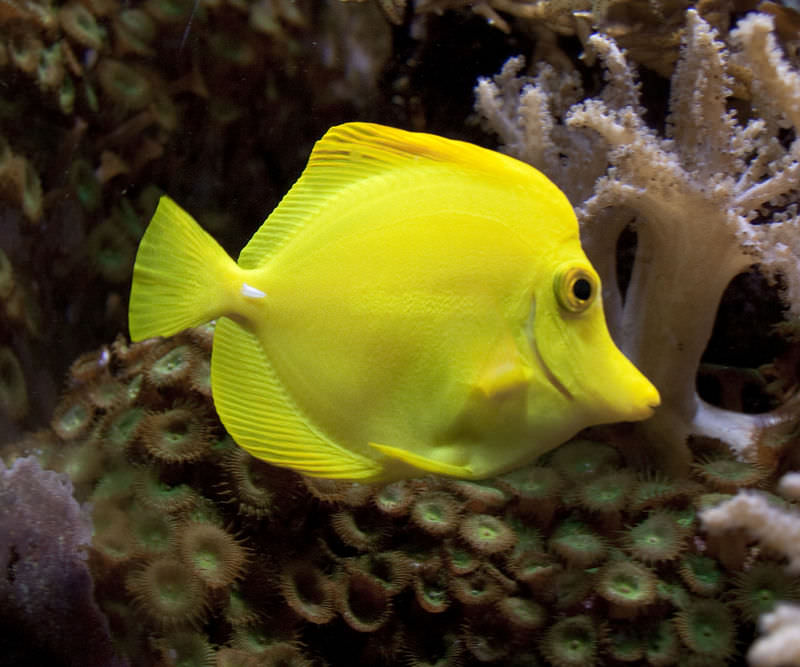 |
[Figure 1] | Credit: Mariana Ruiz Villarreal (LadyofHats) for CK-12 Foundation Source: CK-12 Foundation License: CC BY-NC |
 |
[Figure 2] | Credit: Mariana Ruiz Villarreal (LadyofHats) for CK-12 Foundation Source: CK-12 Foundation License: CC BY-NC 3.0 |
 |
[Figure 3] | Credit: Mariana Ruiz Villarreal (LadyofHats) for CK-12 Foundation Source: CK-12 Foundation License: CC BY-NC 3.0 |
 |
[Figure 4] | Credit: User:The Emirr/Wikimedia Commons Source: http://commons.wikimedia.org/wiki/File:TE-Nervous_system_diagram.svg License: CC BY 3.0 |

